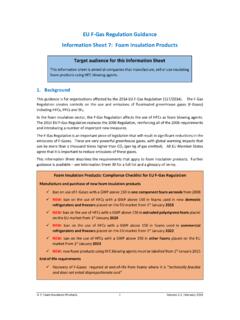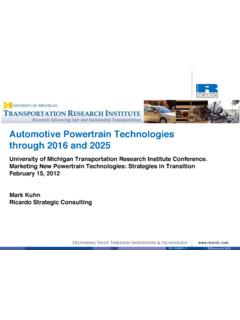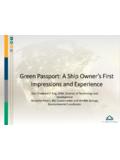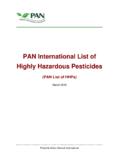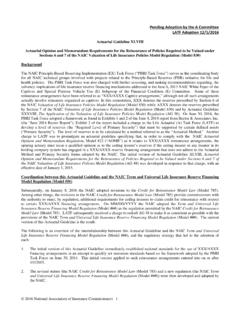Transcription of EU F-Gas Regulation Guidance Information Sheet 16 ...
1 EU F-Gas Regulation Guidance Information Sheet 16: Manufacturers and Importers of Refrigeration, Air-Conditioning and Heat Pump Equipment Target audience for this Information Sheet This Information Sheet is aimed at manufacturers and importers of refrigeration, air- conditioning and heat pump equipment (RACHP). 1. Background This Guidance is for organisations affected by the 2014 EU F-Gas Regulation (517/ 2014 ). The F-Gas Regulation creates controls on the use and emissions of fluorinated greenhouse gases (F-Gases). including HFCs, PFCs and SF6. Manufacturers and importers of refrigeration, air-conditioning and heat pump equipment (RACHP).
2 Using HFC refrigerants have to comply with a number of requirements under the F-Gas Regulation . The 2014 EU F-Gas Regulation replaces the 2006 Regulation , strengthening all of the 2006. requirements and introducing a number of important new measures. The F-Gas Regulation is an important piece of legislation that will result in significant reductions in the emissions of F-Gases. These are very powerful greenhouse gases, with global warming impacts that are several thousand times higher than CO2 (per kg of gas emitted). All EU Member States agree that it is important to reduce emissions of these gases.
3 This Information Sheet describes the requirements that apply to RACHP equipment manufacturers and importers. Further Guidance is available see Information Sheet 30 for a full list and a glossary of terms. RACHP Equipment Manufacturers and Importers: Compliance Checklist for EU F-Gas Regulation NEW: Comply with bans on HFCs in new RACHP equipment NEW: Be aware of the impact of the service ban on selection of new RACHP equipment NEW: Be aware of the impact of HFC phase down on selection of new RACHP equipment NEW: Supply new RACHP equipment with lowest practical GWP refrigerant Design for low leakage and best energy efficiency Ensure products are properly labelled NEW: Comply with rules related to pre-charged equipment NEW: Report details of pre-charged imports IS 16.
4 RACHP Manufacturers and Importers 1 Version , December 2014 . EU F-Gas Regulation Guidance 2. Sector description The RACHP sector covers a wide range of equipment and end users, ranging from small domestic and commercial systems to large industrial plant. Key sectors of the RACHP market include 1. Domestic refrigeration 2. Commercial refrigeration 3. Industrial refrigeration 4. Transport refrigeration 5. Stationary air-conditioning and heat pumps 6. Mobile air-conditioning Detailed Guidance on the impact of the 2014 F-Gas Regulation for owners / operators in these sectors is available in Information Sheets 1 to 6.
5 Manufacturers and importers of RACHP equipment that serve these markets must become fully aware of relevant parts of the 2014 F-Gas Regulation so that they can provide suitable equipment to their customers and comply with certain legal obligations. 3. NEW: Bans on the use of HFCs in certain types of RACHP equipment The 2014 Regulation includes a number of HFC bans as summarised in Table 1. Equipment manufacturers and importers must ensure they do not place any banned products on the market after the dates shown in Table 1. Manufacturers should also be aware that these bans do not tell the full story.
6 The HFC phase down and the service ban (see below) also have a significant influence on selecting refrigerants for new plant. Equipment manufacturers may gain a competitive advantage if they can supply equipment that uses low GWP1 refrigerants. Table 1: Bans affecting manufacturers and importers of RACHP Equipment Market Sector Product Description Scope of banned F-Gases Start Date2. Non-confined direct evaporation systems All HFCs and PFCs 2007. Domestic refrigerators and freezers3 HFCs with GWP > 150 2015. Refrigerators and freezers for commercial use HFCs with GWP > 2,500 2020.
7 Refrigeration (hermetically sealed)4. HFCs with GWP > 150 2022. All stationary refrigeration equipment5 HFCs with GWP > 2,500 2020. Multipack central systems for commercial use F-Gases with GWP > 150 2022. with a cooling capacity above 40kW 6. Air- Moveable, hermetically sealed air-conditioning HFCs with GWP > 150 2020. conditioning Single split systems containing 3 kg or less F-Gases with GWP >750 2025. 1. GWP, Global Warming Potential: see Information Sheet 25 for details about GWP. 2 All start dates are January 1st of year specified 3 This ban includes both refrigerant and foam blowing agent 4.
8 This ban includes both refrigerant and foam blowing agent 5. Exemption for equipment cooling products below -50oC. 6. The primary circuit of cascade systems can use an HFC with a GWP up to 1,500. IS 16: RACHP Manufacturers and Importers 2 Version , December 2014 . EU F-Gas Regulation Guidance 4. NEW: Impact of the Service Ban on sales of new equipment Purchasers of new commercial and industrial refrigeration equipment should be made aware that a Service Ban will affect certain existing systems using HFCs with a GWP above 2,500 from 2020. The ban applies to systems containing more than 40 tonnes CO2 equivalent (10 kg for HFC 404A).
9 To avoid future problems manufacturers and importers should advise clients purchasing plants above this size threshold to select only refrigerants with a GWP below 2,500, with immediate effect. It makes no sense to be purchasing equipment that will need converting or replacing within just a few years. 5. NEW: Impact of the HFC Phase Down on the sales of new equipment When purchasing new RACHP equipment your clients should also consider the HFC phase down7. This will reduce the quantity of HFCs that can be sold in the EU by 2030 there will be an 80% cut in HFC. supply. Equipment bought now will still be operating when deep cuts in HFC supply are in force.
10 Irrespective of the bans shown in Table 1, it will become increasingly important to purchase equipment using refrigerants with the lowest practical GWP to minimise the future impact of the phase down8. 6. HFC Ban in MAC Directive Mobile air-conditioning (MAC) used in cars and light vans are affected by the MAC Directive (2006/40/EC). This bans the use of any refrigerant with a GWP above 150 in new car and light van air- conditioning systems. The ban applies to new vehicle types ( new models) with immediate effect and to all new cars from January 2017. This creates a ban on the standard MAC refrigerant (HFC 134a).


